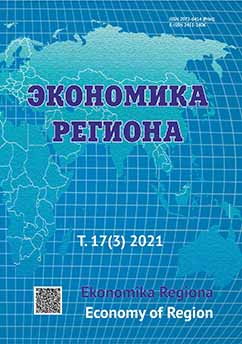Генетический подход к оценке инфраструктурной связанности индустриального региона
Genetic Approach to Assessing the Infrastructure Coherence of an Industrial Region
Author(s): Yuliya Gennadyevna Myslyakova, Svetlana Nikolayevna Kotlyarova, Natalia Alexandrovna MatushkinaSubject(s): Economy, National Economy, Business Economy / Management, Socio-Economic Research
Published by: Институт экономики Уральского отделения Российской академии наук
Keywords: infrastructure coherence; genetic approach; infrastructure gaps; connectivity assessment; inherited management determinants; socio-economic development of the region; industrial region;
Summary/Abstract: In the context of external shocks, socio-economic coherence of an industrial region reflects its ability to function successfully. Many researchers examine economic space, focusing on interaction between entities (including infrastructure) while ignoring territorial boundaries. However, it is necessary to consider a region’s endogenous core, whose historically connected elements generate evolutionary changes under the influence of external factors. This study develops tools to assess regional infrastructure coherence, taking into account the endogenous determinants of its socio-economic development. The research methodology includes: a comparison of absolute and relative territorial characteristics and infrastructure development parameters; statistical, economic and mathematical methods for determining and evaluating the resulting indicators; an expert assessment of the infrastructure potential; a matrix method for identifying the depth of infrastructure gaps. An analysis of Sverdlovsk oblast and neighbouring regions revealed infrastructure gaps of the first level of depth (insignificant, significant, stably significant), violating the integrity of the regional core, as well as gaps of the second level of depth (forming, potentially forming), requiring serious transformations of the core elements. The conducted research determined the infrastructure coherence characteristics of the regional core. Thus, the most favourable situation is in Sverdlovsk oblast, whose core has strong integrity. The most unfavourable situation is observed in Perm Krai and Khanty- Mansi Autonomous Okrug. Perm Krai’s core is characterised by minor gaps of the first level of depth and potential second level gaps. In Khanty-Mansi Autonomous Okrug, significant first level gaps are already established, while second level gaps are still forming. This situation occurred due to the industrial specificity of these regions, as well as the discrepancy between high economic activity (increasing the demand for transport services) and infrastructure development. Further research will focus on the ways to improve the regional connectivity at the intra- and inter-regional levels.
Journal: Экономика региона
- Issue Year: 17/2021
- Issue No: 3
- Page Range: 784-798
- Page Count: 15
- Language: Russian

